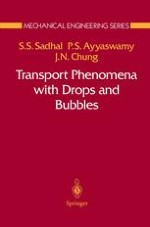1997 | OriginalPaper | Chapter
Transport at Low Reynolds Numbers
Authors : S. S. Sadhal, P. S. Ayyaswamy, J. N. Chung
Published in: Transport Phenomena with Drops and Bubbles
Publisher: Springer New York
Included in: Professional Book Archive
Activate our intelligent search to find suitable subject content or patents.
Select sections of text to find matching patents with Artificial Intelligence. powered by
Select sections of text to find additional relevant content using AI-assisted search. powered by
As discussed in Chapter 1, fluid dynamics at low Reynolds numbers refers to what is commonly known as creeping flow to chemical engineers, and physically corresponds to motion with little or no inertia. Such motion generally arises in systems involving fluids with high viscosity or interacting particles of small dimension. The inertia in a system can be weak, also due to low fluid density or slow fluid motion. The net effect of these parameters is grouped into a Reynolds number. The magnitude of this quantity is in some sense a measure of the relative importance of the inertia of a given system. This is evident from the behavior of the equations of motion discussed in Chapter 1 on pages 5–6. The earliest work in the regime of noninertial flows appears to be that by Stokes [164] who obtained an expression for the drag force on a solid sphere translating in a viscous fluid. This fundamental solution naturally brought about the problems pertaining to fluid spheres, as well as solid particles of other shapes. The parameter of interest usually has been the drag force on a particle undergoing pure translation in a fluid. The behavior of the flow field arising from such motion has also been of interest. The classical development subsequent to Stokes’ [164] was the solution of the slow motion of a fluid sphere given by Rybczynski [143] and independently by Hadamard [69].
